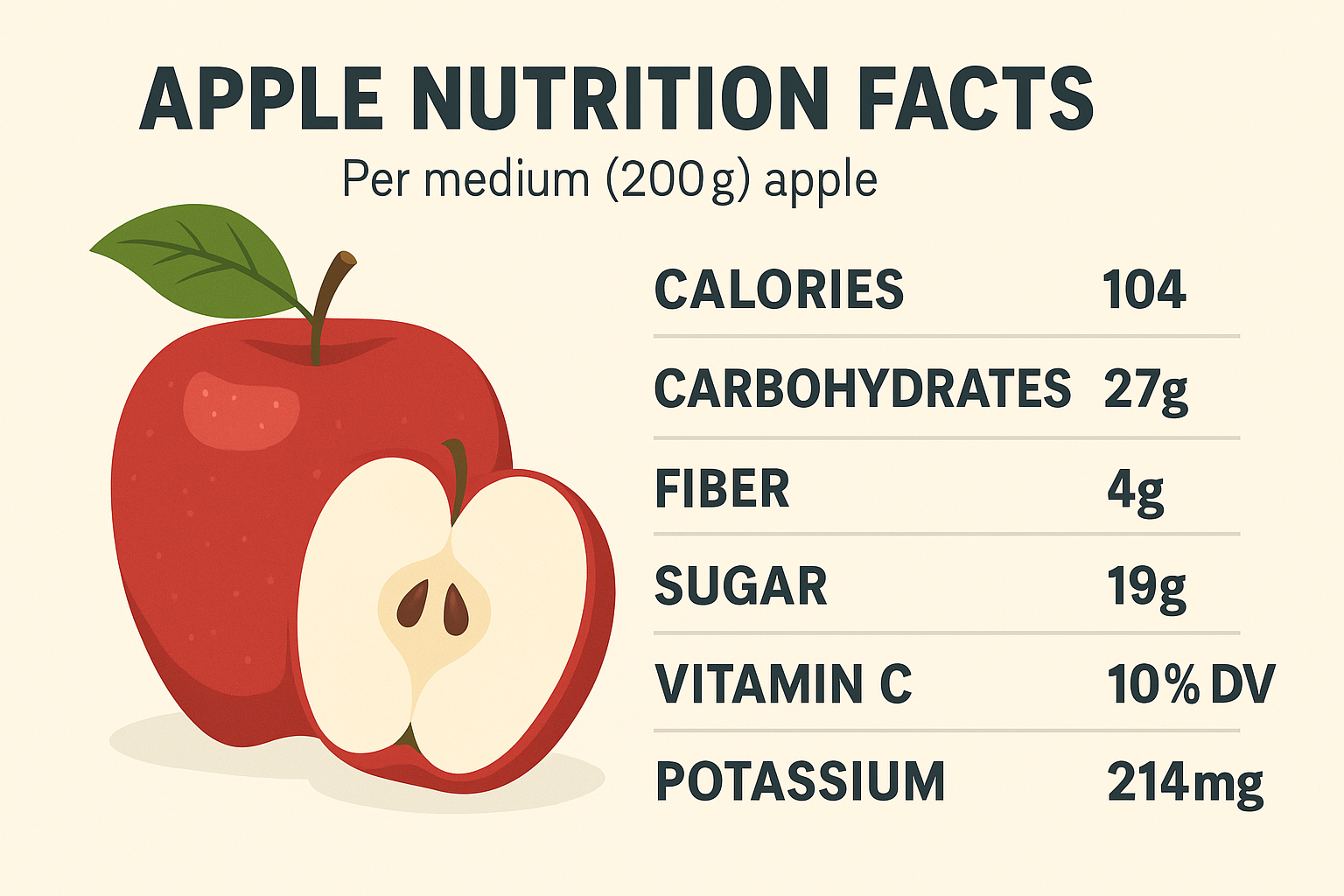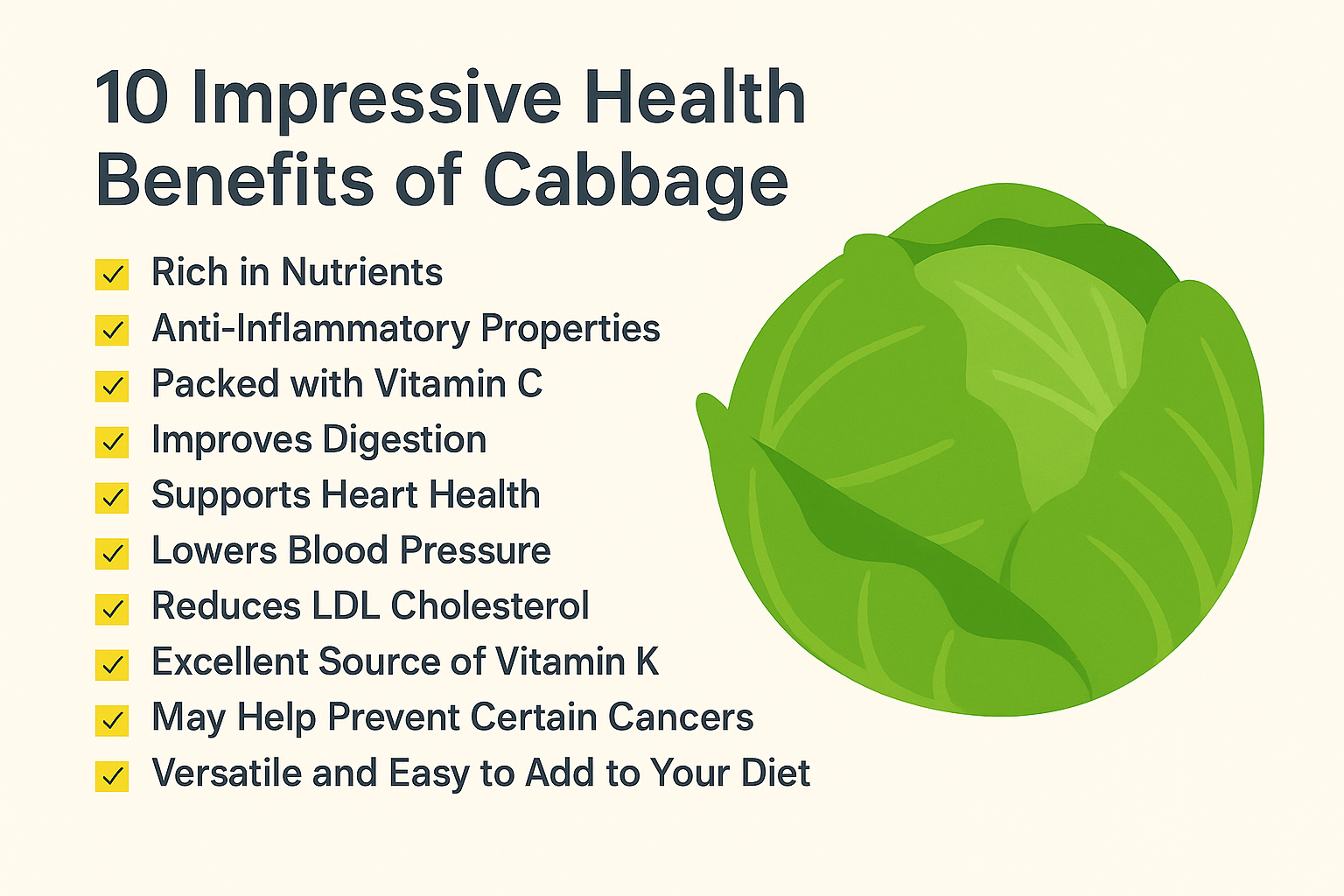
Apple Nutrition Facts: A Complete Guide to Apples, Juice, Cider & Vinegar

Why Apples Are One of the Most Popular Fruits Worldwide
There’s an old saying: “An apple a day keeps the doctor away.” While it may sound like a cliché, it actually reflects just how powerful apples can be when it comes to nutrition. Apples are one of the most consumed fruits worldwide, and for good reason. They’re portable, affordable, widely available in countless varieties, and packed with essential nutrients that contribute to overall health.
Globally, apples are not just a fruit, they’re a symbol of health, longevity, and even knowledge in many cultures. From the classic red apple in school lunchboxes to tart green Granny Smith apples used in baking, this fruit has earned a permanent place in diets around the world. They’re versatile too, enjoyed raw, juiced, baked, turned into cider, or fermented into vinegar.
What makes apples truly special is their nutrient density. While they aren’t loaded with protein like meats or beans, they shine when it comes to fiber, antioxidants, and vitamins. And unlike processed snacks, apples provide natural sweetness without refined sugars, making them a healthier option for satisfying cravings.
The Role of Apples in a Balanced Diet
Apples fit into nearly every type of diet vegetarian, vegan, Mediterranean, low-fat, and even weight-loss plans. They’re naturally low in calories, contain zero fat, and offer a steady release of energy thanks to their fiber content. This makes them ideal for snacking, meal prep, or as part of breakfast.
The dietary fiber in apples (particularly pectin) helps regulate digestion, manage blood sugar, and promote a feeling of fullness. That’s why nutritionists often recommend apples as a smart carb choice. Plus, their mix of vitamin C, potassium, and antioxidants makes them a great immunity booster.
Interestingly, the nutrition profile varies depending on whether you eat a red apple, green apple, or drink apple products like juice, cider, or vinegar. That’s what we’ll explore in detail so you can understand exactly what you’re getting with each apple-based food and make the best choices for your health.
General Apple Nutrition Facts
Apple Nutrition Facts per 100g (Raw Apple)
To get a clear picture, let’s look at the nutrition facts for a standard 100g serving of raw apple (with skin):
- Calories: 52
- Carbohydrates: 14g
- Sugar: 10g (natural sugar, not added)
- Fiber: 2.4g
- Protein: 0.3g
- Fat: 0.2g
- Vitamin C: 8% of Daily Value (DV)
- Potassium: 195 mg
- Vitamin K: 2% DV
The calorie count is low, especially compared to processed snacks of the same weight. Yet, apples provide hydration (since they’re about 85% water) and a good amount of dietary fiber, making them more filling than their calorie content might suggest.
This is why apples are often considered a “nutritional bargain” you get a lot of health benefits for very few calories.
Vitamins and Minerals in Apples
Apples might not be as vitamin-rich as citrus fruits, but they still provide essential nutrients that support health:
- Vitamin C: Supports immune function and skin health.
- Potassium: Helps regulate blood pressure and heart health.
- Vitamin K: Important for blood clotting and bone strength.
- B Vitamins (small amounts): Aid energy production.
- Polyphenols (antioxidants): Found mainly in the skin, these help fight inflammation and oxidative stress.
One key point: Most of the nutrients are in the skin. Peeling apples reduces fiber and antioxidant content significantly. If you want maximum nutrition, eat apples with the peel.
Health Benefits of Eating Apples
Eating apples regularly can provide a wide range of health benefits:
- Supports Weight Management: Low in calories and high in fiber, apples keep you full longer.
- Boosts Heart Health: Potassium and antioxidants help lower blood pressure and cholesterol.
- Improves Gut Health: The fiber (pectin) acts as a prebiotic, feeding good bacteria in the gut.
- Helps Control Blood Sugar: Apples have a low glycemic index, meaning they cause a slower rise in blood sugar than many other fruits.
- Protects Against Chronic Disease: Antioxidants in apples are linked to lower risks of heart disease, diabetes, and even some cancers.
In short, apples are more than just a convenient snack they’re a functional food with real health-promoting properties.
Common Misconceptions About Apples
Despite their popularity, apples often come with a few myths:
- “Apples are high in sugar.”
Yes, apples contain sugar, but it’s natural fructose paired with fiber, which slows absorption. Unlike candy or soda, apples don’t cause a sharp spike in blood sugar. - “Apple juice is just as healthy as whole apples.”
Not quite. Juice lacks fiber and often has added sugars, making it less beneficial than eating the whole fruit. - “Green apples are healthier than red apples.”
Both are healthy, but they differ slightly in sugar, antioxidants, and taste. We’ll compare them in the next section.
Green Apple Nutrition Facts
Nutritional Comparison: Green Apple vs Red Apple
Many people wonder whether green apples (like Granny Smith) are healthier than red apples (like Red Delicious). The truth is, both have benefits, but their nutrition differs slightly:
| Nutrient (per 100g) | Green Apple | Red Apple |
| Calories | ~52 | ~57 |
| Sugar | ~9g | ~12g |
| Fiber | ~2.8g | ~2.1g |
| Vitamin C | Slightly higher | Moderate |
| Antioxidants | Moderate | Higher (more anthocyanins in skin) |
Key takeaway:
- Green apples have less sugar and more fiber, making them a good choice for weight management or blood sugar control.
- Red apples tend to be sweeter and higher in antioxidants, making them great for overall wellness.
Calories, Sugar, and Fiber in Green Apples
A medium-sized green apple (~200g) typically contains:
- Calories: ~100–110
- Sugar: ~18–20g (less than red apples)
- Fiber: ~5g
That fiber is a big deal. Green apples are particularly rich in pectin, a type of soluble fiber that helps with digestion, gut health, and blood sugar regulation. Their tart flavor also makes them less likely to be overeaten compared to sweeter apples.
Unique Health Benefits of Green Apples
Green apples offer some unique perks:
- Better for Weight Loss: Lower sugar and higher fiber mean fewer cravings.
- Good for Blood Sugar: They have a slightly lower glycemic index than red apples.
- Great for Digestion: The tartness stimulates saliva and digestive enzymes.
- Rich in Polyphenols: Especially flavonoids that help reduce oxidative stress.
Best Ways to Eat Green Apples for Maximum Nutrition
Green apples are versatile, but because of their tartness, they’re often used differently than red apples:
- Raw snack with peanut butter or almond butter
- Sliced in salads (pairs well with spinach, walnuts, and goat cheese)
- Baked in pies (holds structure better than red apples)
- Blended in green smoothies for a refreshing tart kick
If your goal is weight control or gut health, green apples are an excellent daily choice.
Apple Juice Nutrition Facts
Calories and Sugar Content in Apple Juice
Now, let’s talk about juice. Apple juice may taste refreshing, but nutritionally, it’s quite different from eating whole apples. A typical 8-ounce (240ml) serving of apple juice contains:
- Calories: ~115
- Sugar: ~24g
- Protein: 0g
- Fiber: 0g
- Vitamin C: ~2–4% DV (unless fortified)
Notice the problem? You get more calories and sugar, but none of the fiber. That’s why nutritionists warn against drinking too much fruit juice it spikes blood sugar quickly and doesn’t keep you full.
Key Vitamins and Minerals in Apple Juice
While apple juice loses fiber, it still provides:
- Potassium (helps with hydration and muscle function)
- Small amounts of Vitamin C (higher if fortified)
- Polyphenols (antioxidants, though much less than whole apples)
If you love apple juice, try cloudy apple juice (unfiltered). It retains more of the antioxidants than clear, filtered versions.
Apple Juice vs Whole Apples – Which is Healthier?
There’s no contest whole apples are healthier. Here’s why:
- Whole apples = fiber + slower sugar release + more antioxidants.
- Apple juice = concentrated sugar + fewer nutrients.
For children and adults alike, it’s better to eat an apple than drink apple juice. If you do drink juice, limit it to 4–6 ounces per day and ideally pair it with a protein-rich snack.
Benefits and Drawbacks of Drinking Apple Juice
Benefits:
- Hydrating and refreshing
- Easy source of quick energy
- Provides some potassium
Drawbacks:
- High in sugar, low in fiber
- Not filling
- Can contribute to weight gain or blood sugar spikes if consumed excessively
In short: enjoy apple juice in moderation, but don’t replace whole apples with it.
Apple Cider Nutrition Facts
What is Apple Cider?
Apple cider is often confused with apple juice, but the two aren’t the same. In the United States, apple cider typically refers to an unfiltered, unfermented beverage made from freshly pressed apples. It’s darker, cloudier, and tangier than apple juice because it still contains apple pulp, sediment, and more natural compounds.
Outside the U.S., the term “cider” often refers to hard cider the alcoholic version made by fermenting apple juice. But here, we’ll focus on non-alcoholic apple cider, the kind you’d find at fall festivals or holiday gatherings.
Nutritionally, apple cider is slightly better than apple juice because it’s less processed and retains more antioxidants and plant compounds. Still, it shares some of the same drawbacks high sugar, limited fiber, and concentrated calories.
Apple Cider vs Apple Juice Nutrition
Let’s compare 8 ounces (240ml) of apple cider vs apple juice:
| Nutrient | Apple Cider | Apple Juice |
| Calories | ~120 | ~115 |
| Sugar | ~24–28g | ~24g |
| Fiber | <1g | 0g |
| Vitamin C | ~2–4% DV | ~2–4% DV |
| Antioxidants | Higher | Lower |
Key Takeaway: Apple cider contains slightly more antioxidants and polyphenols because it’s less filtered. However, its sugar and calorie levels are still similar to apple juice. So while cider may be marginally healthier, it’s not a substitute for whole apples.
Health Benefits of Drinking Apple Cider
Despite the sugar content, apple cider can offer a few benefits in moderation:
- Rich in Antioxidants: Unfiltered cider retains compounds like polyphenols and flavonoids, which support heart health.
- Hydration: With a high water content, cider can be refreshing and hydrating.
- Vitamin C Boost (if fortified): Some brands add extra vitamin C for immune support.
- Seasonal Enjoyment: Warm apple cider with spices like cinnamon and cloves can have added benefits, since spices themselves are antioxidant-rich.
Sugar and Calorie Considerations in Apple Cider
Here’s the downside: sugar. Just like juice, cider can pack 24–28 grams of sugar per glass. That’s the same as a can of soda. Drinking cider frequently can lead to:
- Blood sugar spikes
- Increased calorie intake
- Potential weight gain
If you want to enjoy cider but limit sugar, consider:
- Drinking smaller portions (4oz)
- Choosing unsweetened cider
- Diluting with water or sparkling water
This way, you get the cozy fall vibes of cider without overloading on sugar.
Apple Cider Vinegar Nutrition Facts
Calories and Nutrient Profile of Apple Cider Vinegar
Apple cider vinegar (ACV) has become a wellness trend over the last decade, but what does it actually contain nutritionally? Surprisingly, not much in terms of calories:
- Calories: 3 per tablespoon
- Carbs: 0.1g
- Sugar: 0g
- Fat: 0g
- Protein: 0g
Clearly, ACV isn’t consumed for calories, vitamins, or minerals. Its benefits come mainly from acetic acid (the compound that gives vinegar its tangy flavor and smell) and beneficial plant compounds retained from apples.
Health Benefits of Apple Cider Vinegar (ACV)
Research on ACV suggests several potential benefits when consumed in moderation:
- Blood Sugar Control: ACV may help reduce post-meal blood sugar spikes by slowing digestion.
- Weight Management: Some studies show it increases satiety, helping people eat fewer calories.
- Digestive Aid: Many people use diluted ACV before meals to improve digestion.
- Antimicrobial Properties: Vinegar has natural antibacterial qualities, making it useful for food preservation and even skin applications.
Common Myths About Apple Cider Vinegar
Despite its popularity, ACV is often surrounded by myths. Let’s set the record straight:
- “ACV melts fat directly.”
False. ACV may support weight loss by controlling appetite, but it doesn’t burn fat by itself. - “You should drink ACV straight.”
Dangerous. Undiluted vinegar can erode tooth enamel and damage the throat. Always dilute it in water. - “ACV provides lots of vitamins and minerals.”
Not true. Nutritionally, ACV is very low in vitamins and minerals. The benefits come mainly from acetic acid and bioactive plant compounds.
Best Ways to Use Apple Cider Vinegar in Diet
If you want to add ACV to your routine safely:
- Dilute 1–2 tablespoons in a glass of water before meals.
- Use it in salad dressings, marinades, and sauces for flavor and health benefits.
- Try ACV tea with warm water, honey, and lemon.
Always start small, too much vinegar can cause digestive upset.
Apples for Weight Loss and Fitness
Are Apples Good for Weight Loss?
Absolutely. Apples are one of the best fruits for weight management thanks to their low calorie density and high fiber. Eating an apple before a meal can make you feel full, helping you eat fewer calories overall.
For example:
- A medium apple = ~95 calories
- A bag of chips of the same weight = ~300+ calories
That’s a huge difference in satiety and calorie load. The fiber in apples also helps regulate digestion, which is key in sustainable weight management.
Apples vs Apple Juice for Fitness Enthusiasts
If you’re active or hitting the gym, should you choose whole apples or apple juice?
- Whole Apples: Great for pre-workout snacks, providing carbs and fiber for steady energy.
- Apple Juice: Good for quick energy post-workout, since the sugar is absorbed faster.
But for everyday snacking, whole apples win because they balance sugar with fiber, preventing sugar crashes.
The Role of ACV in Diet and Fat Loss
Apple cider vinegar has gained popularity in the fitness community. Some studies suggest that consuming ACV before meals may reduce appetite and promote small amounts of weight loss over time.
However, it should be viewed as a supporting tool, not a miracle cure. Eating a balanced diet, staying active, and monitoring calorie intake are still the foundations of fat loss.
If you enjoy ACV, use it to enhance meals and support digestion but don’t rely on it as your only weight-loss strategy.
Apples and Blood Sugar Control
Glycemic Index of Apples vs Apple Juice
The glycemic index (GI) measures how quickly a food raises blood sugar.
- Apples (whole): GI = ~36 (low)
- Apple Juice: GI = ~40–50 (medium)
This means whole apples cause a slower, steadier rise in blood sugar, while apple juice spikes it more quickly. For people with diabetes or insulin resistance, whole apples are a better choice.
Can Apples Help Manage Diabetes?
Yes. Studies suggest apples may help reduce the risk of type 2 diabetes. Their fiber slows down sugar absorption, and their polyphenols may improve insulin sensitivity.
Eating one medium apple daily could be a safe, beneficial habit for people managing diabetes. Just be cautious with apple juice and cider, as they can spike blood sugar quickly.
Best Apple Products for Blood Sugar Stability
- Best Choice: Whole apples with skin (fiber intact).
- Moderate Choice: Green apples (slightly less sugar than red).
- Occasional Choice: Apple cider or juice, only in small amounts.
- Supportive Option: Apple cider vinegar (in diluted form, may reduce blood sugar spikes).
If blood sugar control is a priority, stick with whole apples and enjoy juice or cider sparingly.
Apples for Digestive Health
The Role of Fiber in Apples
One of the most important nutrients in apples is fiber. A medium apple provides about 4 grams of dietary fiber, which is roughly 14% of the daily recommended intake. The fiber in apples comes in two forms:
- Soluble fiber (pectin): Helps slow digestion, regulate blood sugar, and lower cholesterol.
- Insoluble fiber: Adds bulk to stool and promotes regular bowel movements.
Together, these types of fiber make apples a digestive superfood. Eating apples regularly can prevent constipation, support gut health, and even reduce the risk of digestive conditions like diverticulitis.
Another bonus: Fiber feeds your gut microbiome. When the good bacteria in your gut ferment apple fiber, they produce short-chain fatty acids (SCFAs) that support colon health and strengthen your immune system.
Apples and Gut Health
The gut microbiome plays a huge role in digestion, immunity, and even mood regulation. Apples contribute positively to gut health in several ways:
- Prebiotic effect: The pectin in apples feeds beneficial bacteria like Bifidobacteria.
- Reduced inflammation: Apple polyphenols may help lower gut inflammation.
- Improved digestion: Regular apple consumption can reduce bloating and improve stool consistency.
A fascinating study found that people who ate apples daily had more diverse gut bacteria than those who didn’t. Since gut diversity is linked to overall health, this is another reason apples should be part of your diet.
Apple Cider Vinegar for Digestion
Apple cider vinegar (ACV) is also widely used for digestive support. While research is still emerging, here’s what we know:
- Stomach acid boost: ACV may help people with low stomach acid digest food better.
- Bloating relief: Some find that diluted ACV before meals helps reduce bloating.
- Gut bacteria support: Raw, unfiltered ACV contains the “mother” , a mix of probiotics and enzymes that may support gut health.
Important note: ACV should always be diluted. Drinking it straight can damage teeth and the esophagus. A safe approach is mixing 1–2 tablespoons in a large glass of water before meals.
Read our previous blogs about Ground Beef Nutrition
Conclusion
Apples are more than just a sweet snack, they’re a nutritional powerhouse that can support nearly every aspect of health. From fresh apples to juice, cider, and vinegar, each form has unique benefits and drawbacks:
- Whole apples are the best option for everyday nutrition low in calories, high in fiber, and rich in antioxidants.
- Green apples offer slightly lower sugar and higher fiber, making them a good choice for weight management and blood sugar control.
- Apple juice and cider can be enjoyed in moderation but should not replace whole fruit due to their high sugar content.
- Apple cider vinegar has unique digestive and metabolic benefits but must be consumed safely and in small amounts.
Ultimately, the best choice depends on your health goals. If you want fullness and fiber, stick to whole apples. If you enjoy juice or cider, keep portions small. And if you’re curious about ACV, incorporate it sensibly into meals rather than relying on it as a miracle cure.
No matter how you slice it (pun intended), apples remain one of the healthiest and most versatile fruits you can add to your diet.
FAQs
How many calories are in a medium apple?
A medium-sized apple (about 200 grams) contains around 95 calories. It also provides ~25g of carbs, ~19g of natural sugar, and about 4g of fiber.
Is apple cider vinegar good for weight loss?
Apple cider vinegar may support weight loss indirectly by reducing appetite and stabilizing blood sugar. However, it doesn’t burn fat directly. For best results, combine ACV with a balanced diet and exercise.
Is apple juice as healthy as eating an apple?
No. Whole apples are healthier because they contain fiber, antioxidants, and fewer concentrated sugars. Apple juice lacks fiber and often has added sugars, making it less filling and less nutritious overall.
Do green apples have more nutrition than red apples?
Green apples are slightly lower in sugar and higher in fiber, making them better for blood sugar control and weight management. Red apples, however, tend to have more antioxidants (like anthocyanins). Both are healthy.
How much apple cider vinegar should I drink daily?
Most experts recommend 1–2 tablespoons diluted in water per day. Drinking more than this can cause digestive issues or harm tooth enamel. Never drink it straight.

Hello! I am Amir
Interesting Posts


Skippy Natural Peanut Butter Option for Your Daily Diet

Prenatal Vitamins and Ulcerative Colitis

Best Vitamins for Energy: Do They Really Work?

How Long Until a Tooth Infection Kills You

Nutrifocal inspires healthier living by delivering trusted nutrition, wellness guidance, and balanced lifestyle choices daily.
- Mark Twain Tweet
Related Posts

Health Benefits of Bacon

Peanut Butter Is It Good for You?

Are There Health Benefits to Eating Sardines?


